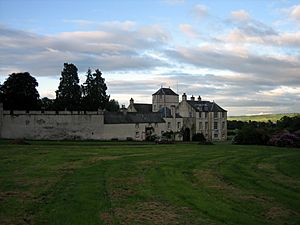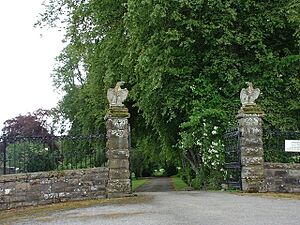Foulis Castle facts for kids
Foulis Castle is a historic building located near Evanton in Ross and Cromarty, Scotland. It's a white mansion that includes parts of an old tower house. This castle has been the home of the Clan Munro for many centuries. They had a strong base here from at least the 1100s.
You can still see the remains of an 11th-century motte in the castle grounds. A motte is a man-made hill with a wooden fence on top. It was likely the first fort at Foulis.
The Castle's Early Story
Foulis Castle is mentioned in records from the 1300s. However, the original Tower of Foulis might have been built even earlier, around 1154. We know that Uilleam III, Earl of Ross gave land to Robert de Munro of Foulis in 1350. This land included "Estirfowlys" and the "Tower of Strathskehech."
Later, in 1394, Euphemia I, Countess of Ross gave two charters to Robert's son, Hugh Munro, 9th Baron of Foulis. One of these charters, from May 4, 1394, mentions "Wesstir Fowlys" and the "Tower of Strathschech." This tower was named after the River Sgitheach, which flows through Strath Skiach and into the Cromarty Firth.
A document from 1491, signed at Foulis Castle, has a special Gaelic phrase. It says "caisteal biorach, nead na h-iolair." This means "castle gaunt-peaked, the eagle's nest." This phrase refers to the eagle symbol used by the Clan Munro chief.
In 1542, Donald Mackay, the chief of the Clan Mackay, was held at Foulis Castle. He was captured after the Battle of Alltan-Beath. Old writings say that the Munros treated Donald Mackay very kindly. Because of this, the Munros and Mackays kept in touch for a long time.
The castle's "tower and fortalice" (a small fort) are also mentioned in a royal document from 1587. During times of clan fights, a signal fire was lit on the highest tower of Foulis Castle. This fire called the clan members to arms. That's why the Munro clan's rallying cry is "Caisteal Foghlais na theine." This means "Castle Foulis ablaze."
Attack and Rebuilding
Foulis Castle stood strong until 1746. In that year, it was attacked by Jacobites. Sir Robert Munro, 6th Baronet, the clan chief, was killed at the Battle of Falkirk Muir in 1746. The Jacobites then attacked and burned Foulis Castle.
Sir Robert's son, Sir Harry Munro, 7th Baronet, returned home after being held captive. He found the castle largely destroyed by fire. Just a few months later, the Jacobites were defeated at the Battle of Culloden. Sir Harry Munro began rebuilding the castle. He used what he could of the old structure.
However, the Battle of Culloden ended the Highland clan system. There was no longer a need for a strong defensive fort. Like many castles of that time, Foulis Castle was rebuilt as a large mansion house. The castle was rebuilt as a grand classical mansion between 1754 and 1792. Foulis Castle is still the home of the Chief of Munro, Hector W Munro of Foulis.
Castle Discoveries
We don't have records of what Foulis Castle looked like before 1746. But during the rebuilding in 1746, some clues were found. It's thought that the castle was surrounded by smaller buildings. These might have been fortified too.
In 1957–59, evidence was found in the courtyard area. It suggested that horses and cattle were kept there. This means the castle was a self-contained community. It could survive a siege if attacked.
The Tower was a strong fort. Its walls at ground level are five feet six inches thick. In May 1985, during repairs to the Courtyard building, something interesting was found. Workers discovered four "cannon loops" hidden behind blocked-up openings. These loops were shaped like inverted keyholes and dated from the early 1500s. They faced north, south, east, and west. Above them was a stone ceiling shaped like a barrel.
This building was once separate from the main castle. It was built as a small fort to defend against attacks. It had a wide "field of fire" all around. Later, perhaps after 1746, the building's use changed. Three of the openings were completely blocked. The fourth was partly blocked, leaving a narrow slit. An iron bar was built into this slit. This opening provided some light and air. It also allowed food to be passed to prisoners. It was likely the castle's jail.
According to Munro family information, some of the original castle's stone wall was found under the plaster of the current mansion house.




